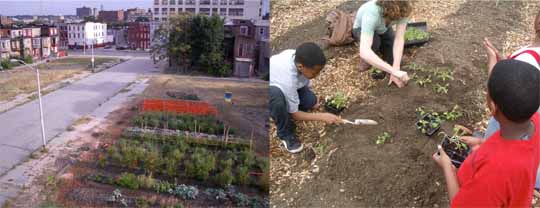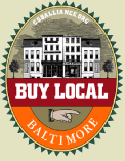Participation Park: Where Art and Politics Meet

Description of P Park by: Scott Berzofsky
Participation Park is an ongoing public art project and activist initiative based on converting a vacant lot in east Baltimore into an urban farm, social space, community kitchen, radical planning studio, free store and adventure playground. Against the increasing privatization of public spaces in the city and the top-down forms of urban planning that design them, we are squatting the land and collaborating with neighborhood residents to produce a space that responds to our collective needs and desires. Inspired by movements to ‘reclaim the commons’ and demand a ‘right to the city,’ the park is an experiment in democratic spatial practice, inviting everyone who participates in the use of the space to engage in the political process of shaping it.
Read a short email conversation between Alyssa and Scott….
A: When was it started? Who started it?
S: The project was started in the winter of 2007 by a group of artists and friends (Dane Nester, Nick Wisniewski and I) in collaboration with neighborhood residents.
A: How did you decide to have it on Forrest St.?
S: We chose this site on the 1100 block of Forrest St. in east Baltimore because it’s pretty big (about 1/3 acre) and it gets full sun all day. Its also a central part of the city that’s hopefully accessible to a diverse public. In addition, the project is about squatting land and reclaiming public space, we wanted to do it in a neighborhood that’s been negatively affected by uneven development and disinvestment. We see it as a form of protest against what David Harvey calls "accumulation by dispossession" — for example, when Johns Hopkins and the City use eminent domain to take 80 acres of land for a biotech park and displace over 300 families in the process. Also, because the project is about growing food, it seemed appropriate to do it in an under-resourced neighborhood without much access to fresh vegetables.
A: Where did funds come from?
S: We received some small grants from a few local non-profit foundations including Parks and People and the baltimore community foundation to buy tools and topsoil, etc. All of our labor has been voluntary.
A: What were the responses from the community?
S: The response has been positive. People in the neighborhood are very supportive. I think they’re glad to see something productive happening on a lot that usually just collected trash. It gives the young people a constructive activity to participate in, and folks can get free food if they want.
A: What were some of the first things planted?
S: The first season we planted a wide variety of vegetables.
A: What were existing soil conditions? How were you able to
bring in soil?
S: We initially did a soil test and found no lead or other contaminants, but found low levels of nutrients. As a result we’re committed to gardening organically. Its been a long process of regenerating the earth by tilling in new topsoil and compost. We’ve also grown cover crops over the winter like buckwheat, rye grass and clover, which add nutrients to the soil. Food Not Bombs dumps their food scraps at the farm and over time we hope to be producing our own high quality compost.
A: Any concerns for protecting the garden?, etc.
S: Protecting the garden in a major concern, because we don’t own the land. At the moment we’ve decided against going the conventional route for gaining land security, which would be to either buy it or put it into a community land trust (which basically means the 501c3 land trust buys it). Both of these approaches reinforce the dominant relations of private property ownership that we want to question. So, instead we’re explicitly squatting as a form of direct action (even though no one seems to care or notice). If there were an attempt to evict us, I would invite it because I think the struggle over the space would generate a productive dialogue about who has the right to the city in Baltimore.





 View the dynamic, moving GOforChange: Greening Baltimore video
View the dynamic, moving GOforChange: Greening Baltimore video
